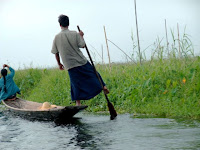
This is the most unusual feature in Inle Lake, "one leg fishermen" who developed an original eccentric method of rowing with one leg, leaving both hands free to drop the tall conical nets over the passing fish while balancing their body at the back edge of their boats. Another reason for not sitting instead of standing up is to easily spot the fish in the swallow lake.




Watching a fascinated way of Intha fishing.




Fishermen freely making a living from the lake, a place where they are borne and live. Intha men standing at the back edge of their sampans and using left leg to do the rowing while women are still using oar by hands.



Intha people are farmers and fishermen, self-sufficient individuals.






Floating gardens are built up from strips of water hyacinth and mud, dredged from lake base, that break down into rich humus.


It takes about 50 years to produce a layer of one meter thick floating allotments.


Maze of canals around the plots mainly grown with vegetables like tomato, beans or sometimes codia leaf which are used to roll tobacco and make cheroots.



The floating allotments are anchored to the bottom by bamboo poles.




The floating gardens are in huge scheme and marked with wooden railing by each and individual farmers. It appears like a flooded racecourse from far.







Nothing is more essential for the villagers at Inle Lake to owe a boat, an important vehicle on water.




Some of these floating houses are shops and business center.



Farmers gather up weeds from deeper parts of lake and make them into floating beds in their garden areas.




Motor boats are the water taxi from village to village.


With Shan Mountain ranges as backdrop, Inle Lake bears comparison with Kashmir's Dal Lake.







Parts of Inle Lake are more like network of canals than an open lake.


No comments:
Post a Comment